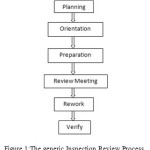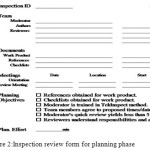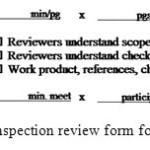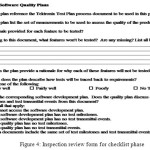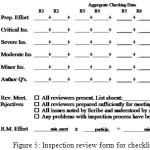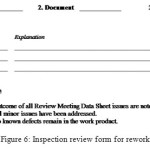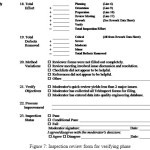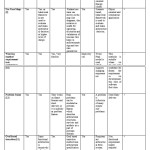Traceability of Implementation to Design and Requirements Specifications: A Formal Technical Review Method (Reverse Engineering Tool)
Introduction
A technical review (TR) is the most effective filter from a quality control standpoint. Conducted by software engineers (and others) for software engineers, the TR (Technical Review) is an effective means for uncovering errors and improving software quality. [1]
Formal techniques are not necessarily mathematical specification languages, but can be graphical techniques as well, provided that the syntax and semantics of these techniques are precisely described. Object Oriented Analysis methods which primarily use graphical specification techniques. The purpose of this study is to look to what extent these graphical specification techniques are formalized. Despite of several advances in automated verification and validation, human review of software artifacts is still a unique important method for software quality improvement. Formal technical review (FTR) is an umbrella term for review methods involving a structured encounter where a group of technical personnel analyzes an artifact in order to improve both the quality of the product and the review process.
In addition, the formal technical review serves as a training ground, enabling junior engineers to observe different approaches to software analysis, design, and implementation. The formal technical review also serves to promote backup and continuity because a number of people become familiar with parts of the software that they may not have otherwise seen.
The formal technical review is actually a class of reviews that includes walk-through’s, inspections, round-robin reviews and other small group technical assessments of software. Each formal technical review is conducted as a meeting and will be successful only if it is properly planned, controlled, and attended.
Literature Survey
A review process can be defined as a critical evaluation of an object. Although the term review process often has many connotations, particularly for those with industry experience, the intent of this module is to use this term in its most general sense.
Formal technical review (FTR) is an essential component of all modern software quality assessment, assurance, and improvement techniques, and is acknowledged to be the most cost-effective form of quality improvement when practiced effectively [2].
Senior technical personnel, project leader decides what should be reviewed .Work products with high impact upon project risks should be reviewed Specify review method and target work products in the software development plan/quality plan. [Philip Johnson]
Boniface C. Nwugwo [3] Formal Technical reviews are the examination of the software product to identify the faults in this work’s author gives the defect Amplification model if we haven’t done formal technical review the error is amplified and generates thirteen errors. If we do the formal technical review generates three errors if we detect an error early it is less costly rather than we found error later. Formal technical review is found defect early reduce the overall cost of the product.Formal techniques can be applied in all phases of software engineering like requirement specification, design, code, testing, user documentation, any other defined development product.
Objective of Formal technical review:
According to [1] the basic objective of formal technical review is:
- To uncover errors in functional, logic, or implementation for any representation of the software;
- To verify that the software under review meets its requirements;
- To ensure that the software has been represented according to predefined standards;
- To achieve software that is developed in a uniform manner.
- To make projects more manageable.
Dr. Jody paul [4]gives the formal technical review through the walk-through and the checklist.
a) Walkthroughs:
In the sections that follow, guidelines similar to those for a walkthrough are presented as a representative formal technical review.Walk-throughs can be viewed as presenting reviews in which a review participant, usually the developer of the software being reviewed, narrates a description of the software and the remainder of the review group provides their feedback throughout the presentation. Features of walkthrough are less formal , producer presents or provides information
Checklist: Requirements Analysis
- Is information domain analysis complete, consistent, and accurate?
- Requirement satisfies the Tool Development objective.
- Is problem partitioning complete?
- Are external and internal interfaces properly defined?
- Does the data model properly reflect data objects, their attributes, and relationships?
- Are all requirements traceable to system level?
- Is performance achievable within the constraints imposed by other system elements?
- Are requirements consistent with schedule, resources, and budget?
- Are validation criteria complete?
In our work we frame the requirement set for re-engineering tool by the formal technical review. Various ways of formal technical review Here we choose the checklist for preparing the requirement of re-engineering tool using formal technical review.
The Formal Technical Review Process
The Review Meeting
Regardless of the formal technical review format that is chosen, every review meeting should abide by the following constraints:
- Between three and five people (typically) should be involved in the review.
- Advance preparation should occur, but should require no more than two hours of work for each person.
- The duration of the review meeting should be less than two hours.
Given these constraints, it should be obvious that a formal technical review focuses on a specific (and small) part of the overall software.
The review meeting is attended by the review leader, all reviewers, and the producer. One of the reviewers takes on the role of the recorder; that is, the individual who records (in writing) all important issues raised during the review. The formal technical review begins with an introduction of the agenda and a brief introduction by the producer. The producer then proceeds to “walk through” the work product, explaining the material, while reviewers raise issues based on their advance preparation. When valid problems or errors are discovered, the recorder notes each. At the end of the review, all attendees of the formal technical review must decide whether to (1) accept the product without further modification, (2) reject the product due to severe errors (once corrected, another review must be performed), or (3) accepts the product provisionally (minor errors have been encountered and must be corrected, but no additional review will be required). The decision made, all formal technical review attendees complete a sign-off, indicating their participation in the review and their concurrence with the review team’s findings.
Review Reporting and Record Keeping
During the formal technical review , a reviewer (the recorder) actively records all issues that have been raised. These are summarized at the end of the review meeting and a review issues list is produced. In addition, a formal technical review summary report is completed.
A review summary report
Answers three questions:
- What was reviewed?
- Who reviewed it?
- What were the findings and conclusions?
The review summary report is a single page form (with possible attachments). It becomes part of the project historical record and may be distributed to the project leader and other interested parties.
The review issues list serves two purposes:
- To identify problem areas within the product.
- To serve as an action item checklist that guides the producer as corrections are made. An issues list is normally attached to the summary report.
It is important to establish a follow-up procedure to ensure that items on the issues list have been properly corrected. Unless this is done, it is possible that issues raised can “fall between the cracks.” One approach is to assign the responsibility to follow up to the review letter.
Review Guidelines
Boniface C. Nwugwo [3] gave
Guidelines for the conduct of formal technical reviews must be established in advance, distributed to all reviewers, agreed upon, and then followed. A review that is uncontrolled can often be worse that no review at all. The following represents a minimum set of guidelines for formal technical reviews:
Review the product, not the producer
A formal technical review involves people and egos.. Errors should be pointed out gently; the tone of the meeting should be loose and constructive; the intent should not be to embarrass or belittle.
Set an agenda and maintain it
A maladies of any meetings is drift. an formal technical review must be kept on track and on schedule.
Limit debate and rebuttal
When an issue is raised by a reviewer, there may not be universal agreement on its impact. Record the issue for further discussion off-line, rather than spend time debating the question.
Don’t attempt to solve every problem noted
A review is not a problem-solving session. Problem solving should be postponed until after the review meeting.
Take written notes
Sometimes it is a good idea for the recorder to make notes on a wall board, so that wording and priorities can be assessed by other reviewers as information is recorded.
Limit the number of participants’ preparation
Two heads are better than one, but 14 are not necessarily better than 4.
Insist upon advance preparation
All review members must prepare in advance. The written command should be solicited by the review leader.
Develop a checklist for each product that is likely to be reviewed
A checklist helps the review led to structure the formal technical review meeting and helps each reviewer to focus on important issues.
Allocate resources and schedule time for the formal technical reviews
To be effective formal technical review scheduled be scheduled as a task during the software engineering process. In addition, time should be scheduled for the inevitable modifications that will occur as the result of a formal technical review.
Review your early reviews
Debriefing can be beneficial in uncovering problems with the review process itself. The very first product to be reviewed should be the review guidelines themselves and your development standard. `
Restrict a Design Review to Reviewing one design
Don’t use a design review to compare two or more designs, but use two or more designs at once, the review may turn into a yelling contest for the advocates of the various alternatives.
Conduct meaningful training for all reviewers
To be effective, all reviews, participants should receive some formal training.
Inspection Review
Inspection review process in six phases in figure1 they are: Planning, orientation, preparation, review meeting, rework and verify and in inspection/ review following function in phase wise, Choose a team, materials, dates. Present product, process, goals. Check product, note issues. Consolidate issues. Correct defects. Verify product/process quality and details are discussed in below section
Following phases of Inspection Review:
Planning: In planning phase -Gather review package, work product, checklists, references, and data sheets.Form inspection team and determine dates for meetings. Procedure for establishment planning -Moderator assembles team and review package, moderately enhances checklist if needed, moderator plans dates for meetings, moderator checks work product for readiness and moderator helps author prepares overview. Figure 2 shows in the details of the inspection, review form in which mention inspection id., team member etc.
Orientation: In this phase first, the author provides an overview, Reviewers obtain review package, Preparation goals established and Reviewers commit to participate. Procedure for establishment Orientation -Moderator distributes a review package, the author presents an overview, if necessary, scribe duty for review meeting assigned and moderator review preparation procedure. Figure 3 shows in the details of the orientation review.
Checklist: In this phase, Find the maximum number of non-minor issues,procedure for reviewers:Allocate recommended time for preparation,perform an individual review of work product, use checklists and references to focus attention, note critical, severe, and moderate issues on reviewer data form and note minor issues and author questions on work product. . Figure 4 shows in the details of the checklist review
Review Meeting: In this phase, Create consolidated, comprehensive listing of non-minor issues,provide opportunity for group synergy,improve is reviewing skill by observing others and create a shared knowledge of work product. The procedure for reviewing mean-Moderator requests, issues sequentially, reviewers raise issues, scribe notes issues on Scribe Data Sheet and scribe data sheet is visible to everyone. Figure 5 shows in the details of the review meeting form.
Rework: In this phase, Assess each issue, determines if it is a defect, and remove it if necessary ,produce written disposition of non-minor issue and resolve minor issues as necessary.
Verify: following function mention in verify phases ,assess the (reworked) work product quality,assess the inspection process,Pass or fail the work product.Procedure for moderator: Obtain reworked on product and author data Sheet,Review work product/data sheet for problems,Provide recommendation for work product,Perform sign-off with reviewers,Compute summary statistics for inspection,Generate any process improvement proposals,Enter review data into quality database.Figure 6 shows in the details of the verify phase
Formal technical review Confirm traceability of implementation to design and requirements specifications. The figure 8 shows how tracebility apply in requirement specification phases.
Conclusion
In this paper concentrate on formal technical review, which are help to us for design requirement set which are validate using different phases of posses of formal technical review and after finding requirement , filtering them on the bases of the available feature set in the different method sets and next to filtering for design qualitative requirement set for reverse engineering tool and the final, formal technical review Confirm traceability of implementation to design and requirements specifications.
References
- Rogers S. Pressman “Software Engineering A practioners Approach” Fifth Edition.2006
- Philip M. Johnson supporting technology transfer of formal technical review through a computer supported collaborative review system, in Proceedings of the Fourth International Conference on Software Quality, Reston, VA., October 1994.
- [Philip M. Johnson] Philip M. Johnson “Reengineering Inspection” COMMUNICATIONS OF THE ACM February 1998/Vol. 41, No. 2.
- Boniface C. Nwugwo” Implementing a Formal Technical Review Process in a Software Development Environment. Kodak software Quality Mini Conference November 12, 1993
- Dr. Jody paul structured walkthroughs and Formal Technical review. http://www.jodypaul.com/SWE/WT/walkthroughs.html#top
- Kang, Kyo C. “Feature-Oriented Domain Analysis Feasibility Study “(CMU/SEI-90-TR-21, ADA235785) CMU-SEI 1990.
CrossRef
- C. Reid Turner “A conceptual basis for feature engineering”, The Journal of Systems and Software 49 (1999) 3-15.
CrossRef
- Dongyun Liu Hong Mei “Mapping requirements to software architecture by feature-orientation”Volume: 25, Issue: 2, Pages: 69-76 Requirements Engineering (2003).
- H. Kaindl, “Difficulties in the Transition from OO Analysis to Design,” IEEE Software, vol. 16, pp. 94-102, 1999.
CrossRef
- J.A.Buhr,”Use Case Maps as Architectural Entities for Complex Systems,” IEEE Transactions on Software Engineering, vol. 24, pp. 1131-1155, 1998.
CrossRef
- Nuseibeh, “Weaving together requirements and architectures,” IEEE Software, vol. 34, pp. 115-11, 2001.
- M. Bradozzi and D. E. Perry, “From Goal-Oriented Requirements to Architectural Prescriptions: The Preskriptor Process,” The Second International Workshop on Software Requirements and architectures(STRAW ’03) at ICSE’03, Portland, OR, 2003.
- J. G. Hall, M. Jackson, R. C. Laney, B. Nuseibeh, and L. Rapanotti, “Relating Software Requirements and Architectures using Problem Frames,” IEEE Joint International Requirements Engineering Conference (RE’02), Essen, Germany, 2002.
- W. Liu and S. Easterbrook, “Eliciting Architectural Decisions from Requirements sing a Rule-based Framework,” The Second International Workshop on Software requirements and Architectures (STRAW ’03) at ICSE’03, Portland, OR, 2003.
- W. Liu, “Architecting Requirements,” Doctoral Consortium at RE’04, Kyoto, Japan, 2004.
- Lihua Xu, Hadar Ziv “An Architectural Pattern for Non Functional Requirements “Elsevier Science Direct 2006.

This work is licensed under a Creative Commons Attribution 4.0 International License.
